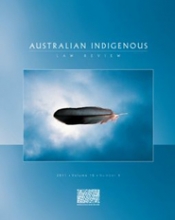Volume 15 Number 1

Introduction
Hal Wootten AC QC
Commentary
Punishment: Two Decades of Penal Expansionism and Its Effects on Indigenous Imprisonment by Chris Cunneen
Aboriginal Identity – The Legal Dimension by Chief Justice Robert French AC
A Reflection on the Royal Commission into Aboriginal Deaths in Custody and Its Consideration of Aboriginal Women’s Issues by Megan Davis
Police Officers’ Experience of Indigenous ‘Capacity’ by Margaret Mitchell and Tim Rowse
Indigenous Women in Australian Criminal Justice: Over-represented but Rarely Acknowledged by Julie Stubbs
Twenty Years of Monitoring Since the Royal Commission into Aboriginal Deaths in Custody: An Overview by the Australian Institute of Criminology by Laura Beacroft, Mathew Lyneham and Matthew Willis
Practice
Editorial Introduction
A Contemporary Snapshot of Two Issues Upon Which the RCIADIC Report Commented: Youth Justice and the Over-incarceration of Aboriginal Young People, and Alcohol-Related Offences and Offending by Shanna Satya and Ruth Bella Barson
The Coroner’s Recommendation: Fulfilling its Potential? A Perspective from the Aboriginal Legal Service (NSW/ACT) by Raymond Brazil
Cover Artist: Michael Riley
The late Wiradjuri/Kamilaroi artist Michael Riley (1960–2004) is widely considered to have been one of the most important contemporary Australian artists of the past two decades. His contribution to the urban-based Indigenous visual arts industry was substantial. Over the course of his career he created an impressive body of work ranging from black-and-white portraiture to film, video and large-scale digital photography. Throughout, his concern was to celebrate the spirit of his people while also bearing witness to their struggles. He had a deep commitment to the process of reconciliation.
Riley’s work draws upon a multiplicity of influences: European and Western (particularly British and North American) Indigenous and non-Indigenous filmmaking; international fashion and design; and Indigenous and European spirituality and its contradictions. His portraits of family and community were the antithesis of the bleak photojournalist studies of contemporary Aboriginal life in towns and cities so often portrayed in print media of the day, with the obvious warmth between subject and photographer evident in the photographs.
Riley’s work is represented in various major public and private collections throughout the country, including the National Gallery of Australia. In early 1998, a debilitating illness impacted on his professional and personal life. Riley’s last and most significant body of work – cloud (2000), from which the cover image for this volume of the AILR was drawn – shifted from terra firma to otherworldly locations and concerns.
Subscribe
To find out more please click here.


